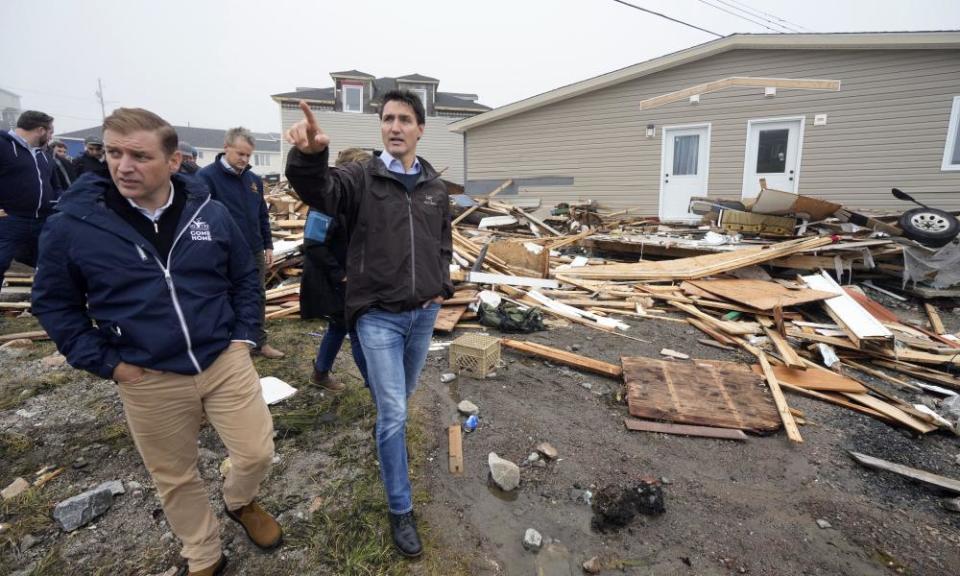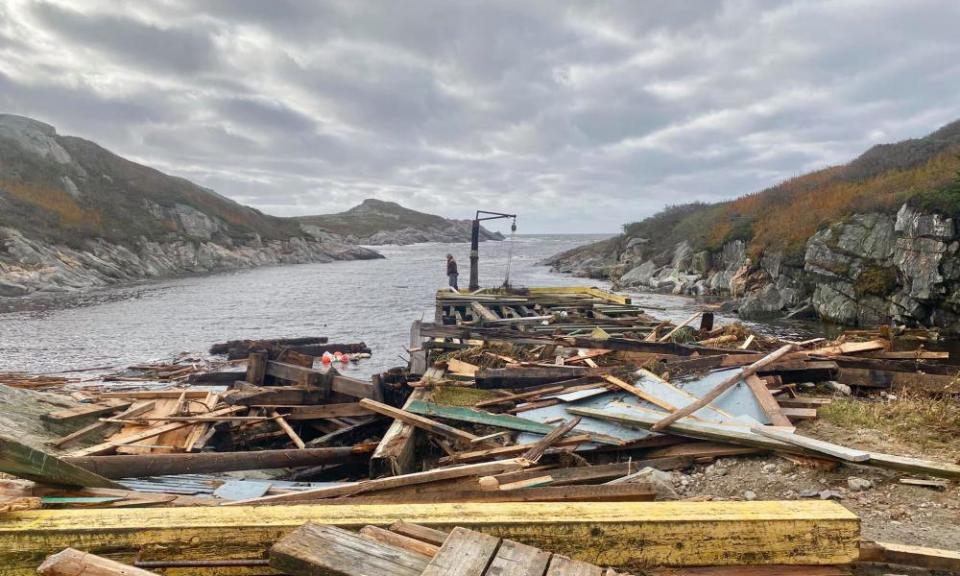Canada begins Storm Fiona cleanup as scale of devastation becomes clear

Brian “Smokey” Osmond was cooking at his home in Newfoundland’s coastal Port aux Basques when he spotted flood waters creeping into his garage on Saturday morning.
Osmond moved his truck up a hill to safety. But as he returned, a powerful storm surge struck.
Related: ‘We’re natural fighters’: Cubans brave sweeping power cuts in Hurricane Ian aftermath
“I went back in the door and a wave took me and I went under,” he told CBC News. “I thought I was gone.”
Osmond was dragged towards the cove before miraculously freeing himself. When he arrived, soaking wet, at a neighbour’s house, he watched in disbelief as a second wave completely destroyed his home.
“It was just luck,” he said. “It wasn’t my time to go.”
In the days since post-tropical storm Fiona battered Atlantic Canada, the scope of devastation has become painfully clear for residents. The powerful derecho, the worst to ever hit the region, killed two people, flattened dozens of homes, washed land into the ocean and left hundreds of thousands in Nova Scotia, southern Newfoundland and Prince Edward Island without power. As residents look to the daunting cleanup and rebuilding efforts, experts says the hundreds of millions in damage highlights the need to build defensively against the effects of climate change.
“Unfortunately, the reality with climate change is that there’s going to be more extreme weather events. We’re going to have to think about how to make sure we’re ready for whatever comes at us,” prime minister Justin Trudeau told reporters as he witnessed the destruction in Nova Scotia. The federal government has dispatched nearly 600 Canadian Armed Forces soldiers to help with the cleanup and pledged immediate aid to residents.
Larger urban centres such as Halifax were largely spared the worst of the storm, but houses across the region were reduced to rubble and debris, roads washed away, and thousands of trees knocked town by uncharacteristically strong winds, which gusted at 190km/h at their peak.
By Wednesday, more than 160,000 people were still without power and heavy rain in some parts hampered cleanup efforts.
“We’ve been hit by something bigger than we’ve ever been hit with before,” Dennis King, the premier of Prince Edward Island, told reporters. “We’re all feeling the effects of that. We’re all very fragile.”

Prince Edward Island, famed for its agriculture, is bracing for significant destruction to potato, soybean and apple crops, which are among the main economic drivers of the province. Fishing boats and potato-storage buildings were also heavily damaged. A spokesperson from Parks Canada said the force of the storm left a “shocking” level of erosion in its wake. Much of the island is hemmed in with distinct red sands, which help keep the ocean at bay. In many areas, the dunes were swept into the ocean, and it will take years for nature to rebuild.
While Trudeau lamented the destruction, he also praised the “tremendous stories of resilience” that have emerged.
In the hard-hit Nova Scotia town of Glace Bay, Carol and Leo Yang, the owners of Jay’s Chicken and Ribs, handed out hundreds of free hot meals to residents, cooking under the light of donated flashlights with a propane stove.
“We started out just trying to help neighbours. But as a restaurant owner, I knew there was something more we could do,” Carol told the Guardian.
Hundreds of residents have lined up outside the Yangs’ two locations for their first hot meal in days. Customers, some of whom have no houses to return to, hugged her as she handed them the boxed-up food.
“They tell me the meal has warmed their bodies and their hearts,” she said.
She and her husband worked as pharmacists in China before immigrating to Nova Scotia 10 years ago. They bought the restaurant six years ago and run it with their young daughter.
Yang says more than 1,000 meals have gone out to those in need and donations have come in – locally and from other provinces – to help her family keep cooking.
The devastation is expected to costs hundreds of millions, according to early estimates from insurers, putting it on track to become the costliest storm in the region’s history. Because storm surges are not covered by insurance, many residents will likely have to bear the cost themselves.
“This type of destruction actually gives us a golden opportunity to put things back in a better way,” said Glenn McGillivray, the managing director of the Institute for Catastrophic Loss Reduction. “And it’s critical because we’re going to see more of these in these intense storms future. Climate change is a direct reason for that. The east coast has to get better prepared.”
He said all new infrastructure projects or rebuilds should go through a climate assessment. McGillivray also cautioned against rebuilding in areas where climate risk is highest, including coastal communities.
“The storm did exactly what the forecasters said it would do. It went where they said it would go. And it was as powerful as they said it was going to be. The damage came from very high winds, very heavy rains and storm surges, especially in small, isolated communities,” he said.
“And so we saw those Newfoundland saltbox buildings, sitting perched on the rocks that you see on postcards, they just can’t handle this kind of storm.”
While Ottawa has increasingly highlighted and supported improvements to construction, McGillivray says more needs to be done for resilience within the federal building code.
“We just have this propensity to kind of put things back the way they were. Everybody wants to get their life back to normal as soon as possible, which is understandable. But that’s not going to work in a changing climate.”

 Yahoo Movies
Yahoo Movies 